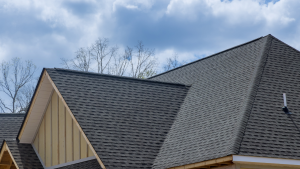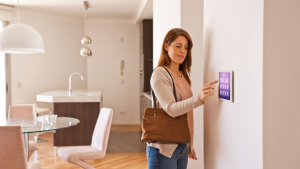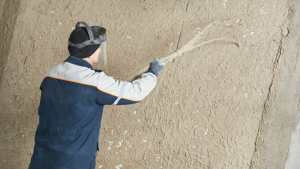A wide variety of stucco is available on the market, and selecting the right kind for your house might be challenging.
This article was written to help you understand the various types of stucco so that you can then proceed to make a decision based on accurate information.
What is Stucco?
For thousands of years, cement-based stucco, also known as plaster, has been used as a building material and is still in use today. It has been used in some way in all the different parts of the globe. Additionally, it is a widely used building material in New Jersey.
Many people have the misconception that stucco refers to just one specific material. Still, in reality, it is an umbrella word that describes a variety of construction materials that adhere to the same fundamental architectural principles.
The image on the left depicts a standard three-coat stucco system utilized in the United States of America today. The “hard coats” in the system are the base coats, the two grey materials.
Stucco is produced by combining Portland cement, sand, and water. Once created, it may be applied to a wall or another surface to create a durable exterior for a house. To use it on the substrate you are working with; you may either spray it on or trowel it on. Its purpose is to shield the structure from the outside environment and maintain the insulation’s position within the structure.
Portland cement is the “hard coat” basis used most often in stucco systems. The term “hard coat” was given to stucco because it used Portland cement as the base material. This is the “hard coat” employed in stucco systems the most often, and it is also the component responsible for giving stucco its famous label of “hard coat.” Stucco, made of Portland cement, is a popular construction material in New Jersey.
EIFS (Exterior Insulation Finishing System)-
This is a stucco finish that is used as a material for cladding the exterior of a building. Exterior Insulation and Finish Systems, more commonly known as EIFS, were initially developed in the 1960s and 1970s as a retrofit to masonry walls after World War II. It was widely used in the 1970s to conserve energy for heating and cooling, contributing to the decade’s surge in popularity for the practice.
What is EIFS?
EIFS, which stands for Exterior Insulation Finishing Systems, is a synthetic stucco system utilized in the finishing process of the exterior of a house. The method has been widely accepted in Europe and has been put into practice in the United States and Canada since the late 1970s. The Exterior Insulation and Finishing System (EIFS) is a synthetic version of stucco built in layers for reinforcement. There are two primary varieties of EIFS, the one-coat and the three-coat varieties. The one-coat is a single layer typically composed of polyurethane and does not include either a base coat or a finish coat. A base coat, a scratch coat, and a brown coat are the three layers that make up the more conventional stucco application method known as the three-coat system.
On the outside of the house, a barrier that is water-resistant will be installed. In most cases, a synthetic material will be utilized to construct the water-resistant wall. If the water-resistant barrier is installed correctly, it will produce a vapor barrier, stopping moisture from entering the house. This will keep the home from being damaged.
Compared to the more conventional method of stucco application, the EIFS system is a more energy-efficient alternative. Copper, aluminum, wood, and vinyl are all more expensive than this material, which makes it a desirable choice. Synthetic stucco is an excellent option for use in regions prone to high winds and severe weather conditions because of its durability. In contrast to conventional stucco, it is not susceptible to damage from exposure to the outside environment.
The exterior insulation and finish system (EIFS) cannot catch on fire and is very resistant to fire. EIFS is ideal for residential construction projects when high-quality fire protection is necessary. Because of its naturally occurring fire-resistant qualities.
EIFS Advantages
EIFS is a product with a very high energy efficiency rating, in addition to having a number of other distinct benefits. It is a more economical alternative to traditional stucco, given its ability to complete the application in a shorter amount of time. In addition, it is an excellent option for locations with a high probability of being affected by wind and rain. For instance, exterior insulation and finish systems (EIFS) are effective in coastal regions. EIFS is an excellent option for use in areas prone to heavy rain because, compared to traditional stucco, it has a lower water permeability rate. Additionally, the material can withstand the effects of freezing and thawing without being damaged.
The EIFS system is a long-lasting product with a lifespan of up to half a century. It can withstand severe weather conditions and various elements found in the outside environment, such as rain, hail, snow, and sun. There are several applications of EIFS that are capable of assisting in insulating a house from the sun’s heat. It can withstand the test of time since environmental factors do not easily damage it. Additionally, the product has excellent resistance to fire.
In addition, EIFS can be painted over, and pressure washed for an additional layer of maintenance convenience.




